#cranbrook papers
Explore tagged Tumblr posts
Text

From our stacks: Illuminated letter 'S' from Cranbrook Papers By the Cranbrook Society, Detroit, Michigan, U.S.A. First Book. Printed and Illumined at The Cranbrook Press, 65 Shelby Street, Detroit, Michigan, U.S.A., and finished on the 31st day of August, 1901.
"And the illuminated letters, borders, and other ornaments used in Cranbrook Paper are copies from or made after the works of ancient masters as found contained in rare books and missals of the Fourteenth and Fifteenth centuries, no attempt having been made to modernize either the letters or other devices or to introduce coloring effects to please personal tastes. The examples herein contained of this interesting art are in strict harmony with the originals after which they were created."
#s#books#illuminated manuscript#book#illustration#old books#book illustration#detroit#michigan#cranbrook papers#cranbrook#1901#detroit public library
52 notes
·
View notes
Photo

Loja Saarinen and Eliel Saarinen, Study for the Festival of the May Queen Tapestry, 1932. Watercolor and gouache with pencil underdrawing on tracing paper. Cranbrook Art Museum.
156 notes
·
View notes
Photo
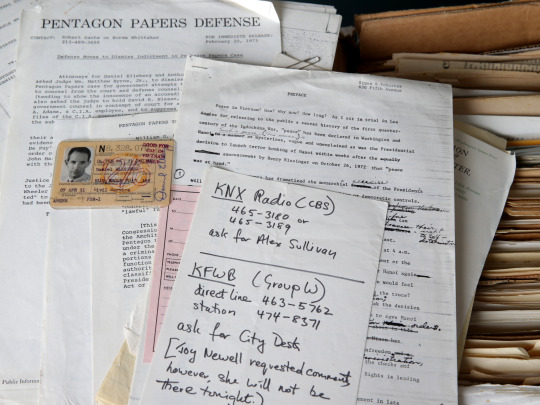
Daniel Ellsberg, who has died aged 92, was the most important whistleblower of our times. His 1971 leaking of what became known as the Pentagon Papers showed conclusively that virtually everything the American public had been told by its leaders about the Vietnam war, from its origins to its current conduct, was false.
The leak itself did not end the war, and Ellsberg regretted not having come forward years earlier. He spent the rest of his life as a peace activist, encouraging others on the inside to reveal government malfeasance, and supporting those who did, including the 2003 GCHQ whistleblower Katharine Gun. But his leaks did result in a landmark decision in favour of freedom of the press, and, ironically, led to the downfall of the US president Richard Nixon. It is not unreasonable to set Ellsberg’s leak alongside President John F Kennedy’s assassination as the ground zero of today’s distrust of politics.
Before working on the Pentagon Papers, officially a study titled A History of Decision-Making in Vietnam 1945-68 commissioned from the Rand Corporation research organisation by the secretary of defense Robert McNamara, Ellsberg had spent two years at the US embassy in Saigon, advising on General Edward Lansdale’s “pacification” programme. As he sifted through the material gathered for the report, including evaluations which deemed the war unwinnable, he realised the enormity of the political fraud.
He began copying the documents, with the help of a former Rand colleague Anthony Russo, and in 1971, as the US extended the war with bombings of Laos and Cambodia, resolved to make them public. The chair of the senate foreign relations committee, William Fulbright, turned him down, as did the Washington Post’s editor Ben Bradlee and owner Katharine Graham; Graham was close to the secretary of state Henry Kissinger, who had known Ellsberg at Harvard; he advised her Ellsberg was “unbalanced and emotionally unstable”. Matthew Rhys played Ellsberg in the 2017 film The Post which loosely covers those events.
Neil Sheehan of the New York Times was a reporter Ellsberg admired in Vietnam; Sheehan convinced the Times to take the papers, the first instalment of which revealed that the Gulf of Tonkin incident, the casus belli which launched full-scale US participation in the conflict, had been bogus.
The Nixon administration obtained an injunction prohibiting further publication; the supreme court’s overturning of that injunction, dismissing the idea of “prior restraint”, remains a cornerstone of US journalistic freedom. But leakers themselves were not protected. Ellsberg was hidden by anti-war activists while Mike Gravel, the US senator from Alaska, entered most of the leaked papers into the congressional record, and the Post played catch-up.
Meanwhile Nixon, furious at the leaks, created the so-called “plumbers” covert special investigation unit, to discover if Ellsberg had further material that might affect him directly, and to discredit him. When the plumbers’ bungled break-in at the Watergate offices revealed an earlier burglary of Ellsberg’s psychiatrist’s office, the ensuing chain of scandal and cover-up eventually forced Nixon’s resignation to avoid impeachment.
Ellsberg grew up the very definition of a true believer in America. Both his father, Harry, a structural engineer, and mother, Adele (nee Charsky), were the children of Russian Jewish immigrants, but had converted to Christian Science. When Daniel, born in Chicago, was six, his father found work in Detroit, building Ford’s massive Willow Run factory.
Daniel won a scholarship to the elite Cranbrook school in the Detroit suburbs; a talented pianist, he practised for four to six hours a day to fulfil his mother’s dream. But in 1946, rushing to Denver for a family gathering, his father fell asleep while driving and rammed into a bridge. His mother and younger sister, Gloria, both died; Daniel recovered from his severe injuries, but ceased playing the piano.
He won a scholarship to Harvard, where he studied economics, edited the college paper, and finished third in his class. Upon graduation he married a Radcliffe student, Carol Cummings, whose father was a colonel in the Marine Corps, and took up a Wilson fellowship for a year’s study at King’s College, Cambridge. In 1954, accepted as a Harvard junior fellow to pursue his doctorate, he instead joined the Marines, becoming a rare first lieutenant given command of a full company.
He returned to Harvard in 1957. His dissertation, Risk, Ambiguity and Decision, contained what is now known as the Ellsberg paradox, which delineated how the preference for well-defined probabilities, over the uncertainty of ambiguity, influences decision-making, especially as it reinforces preconceived ideas. It became an important part of game theory, and Ellsberg went to work for Rand on the Department of Defense’s Command and Control research, much of which was devoted to spit-balling Fail Safe/Dr Strangelove scenarios, as detailed in his 2017 book The Doomsday Machine: Confessions of a Nuclear War Planner.
In 1964 he went to the Department of Defense, as special assistant for international security to McNamara’s number two, John McNaughton, before moving to the State Department and Vietnam. In 1967 he rejoined Rand to work on McNamara’s project, but was increasingly tormented by Kissinger and Nixon’s Vietnam policy; they believed that if the US opened relations with China and entered into a detente with Russia, those countries would pressure North Vietnam to come to the table while the US bombed incessantly.
Ellsberg began joining anti-war campaigners, including the poet Gary Snyder, and was inspired by Randy Kehler, a draft-resister who spoke of welcoming imprisonment for his belief. Ellsberg left Washington for MIT’s Centre for International Studies a year before leaking the papers. His first marriage had ended in divorce; in 1970 he married Patricia Marx, a peace activist.
In June 1971, he surrendered himself to the US attorney in Boston; asked on the courthouse steps how he felt about going to prison, Ellsberg replied: “Wouldn’t you go to prison to end this war?” He became the first civilian charged with violating the 1917 Espionage Act, and faced a maximum sentence of 115 years. The District Court judge William Byrne ruled irrelevant his public-interest defence, that the documents were “illegally classified”, and so it has been for every whistleblower since. But Byrne eventually dismissed the case because of government malfeasance, including the plumbers’ break-ins, as well as Nixon’s wiretapping of Kissinger’s aide Morton Halperin, and John Ehrlichman’s offering Byrne the directorship of the FBI.
In 1974, Ellsberg’s moving interviews were a major part of the Oscar-winning Vietnam documentary Hearts and Minds. In 1978 he was awarded the Gandhi prize by Promoting Enduring Peace. In the next 40 years he was arrested around 50 times at anti-war protests. He likened the weapons of mass destruction excuse for invading Iraq in 2003 to the Gulf of Tonkin affair, and over the years supported leakers who revealed government deceptions, including Edward Snowden, Chelsea Manning and Reality Winner, who was sentenced to five years in prison for leaking a single page from an in-house National Security Agency magazine showing the NSA had concluded Russia interfered in US elections, while the government was maintaining they had not.
He recognised a practical corollary to the Ellsberg paradox: the more secrets you are able to access, the less able you become to act sensibly with them. In 2021, Ellsberg released government memos from 1958, showing that the joint chiefs of staff had prepared a nuclear first-strike against Chinese bases on Quemoy and Matsu during the Taiwan Strait crisis, with a full nuclear attack planned on China should they respond. His point was that little had changed since the Pentagon Papers.
Ellsberg was played by James Spader in the 2003 film The Pentagon Papers, and was the subject of a 2009 documentary, The Most Dangerous Man in America. His memoir, Secrets, appeared in 2003 and in 2021 Risk Ambiguity and Decision was updated as a book, once again challenging the concept of rational decision.
Ellsberg is survived by his wife and their son, Michael, and his son, Robert, and daughter, Mary, from his first marriage.
Daniel Ellsberg, military analyst and political activist, born 7 April 1931; died 16 June 2023
Daily inspiration. Discover more photos at http://justforbooks.tumblr.com
22 notes
·
View notes
Text
More Images of 1910 -
1910 Mary Rosamond Anstruther, Mrs Edward Windsor Hussey by James Jebusa Shannon (Scotney Castle - Lamberhurst, Tunbridge Wells, Kent, UK). From reddit.com/r/vintageart/comments/y59sqx/ james_jebusa_shannon_mary_rosamond_anstruther_mrs/ 2122X3130.
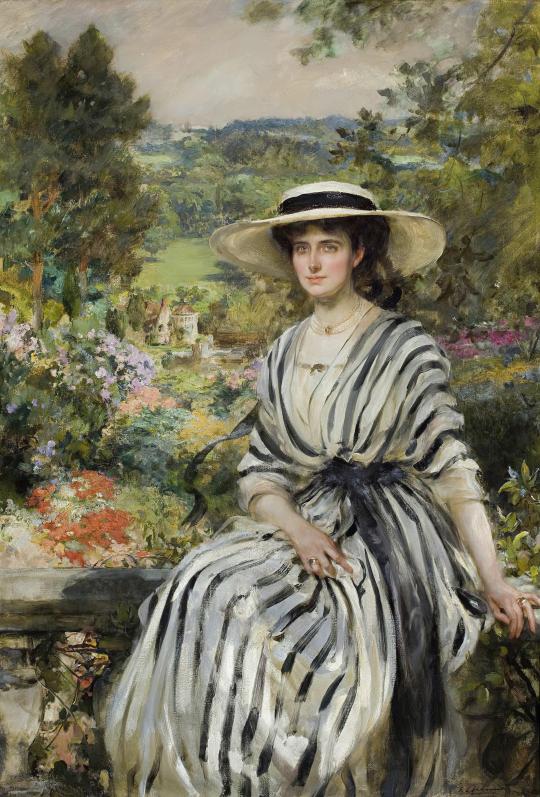
Left 1910 Portrait of a lady by Eudolf Bering (auctioned by Flanders Auctions). From liveauctioneers.com-item-148074085_rudolf-bering-xix-xx-portrait-of-a-lady-oil-on-canvas-w-134-x-h-173-cm; fixed flaws w Pshop 3702X5015.
Right 1910 Vera Nikolaevna Epancies by Alexander Murashko (The National Art Museum of Ukraine - Kiev, Ukraine). From artchive.ru/oleksandrmurashko/works/403439~Portrait_of_Vera_Nikolaevna_Epancies_in_marriage_FalzFEIN#show; fixed spots w Pshop 1110X1400.


Left 1910 The Feather Fan by William Strang (location ?). From tumblr.com/beautifulcentury 880X1200.
Right 1910 The Pink Rose by Lilla Perry (private collection). From the discontinued Athenaeum Web site 592X782.
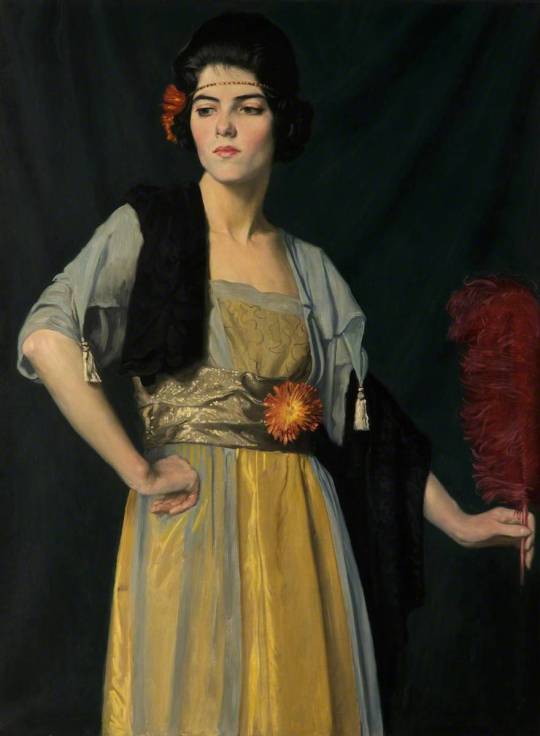
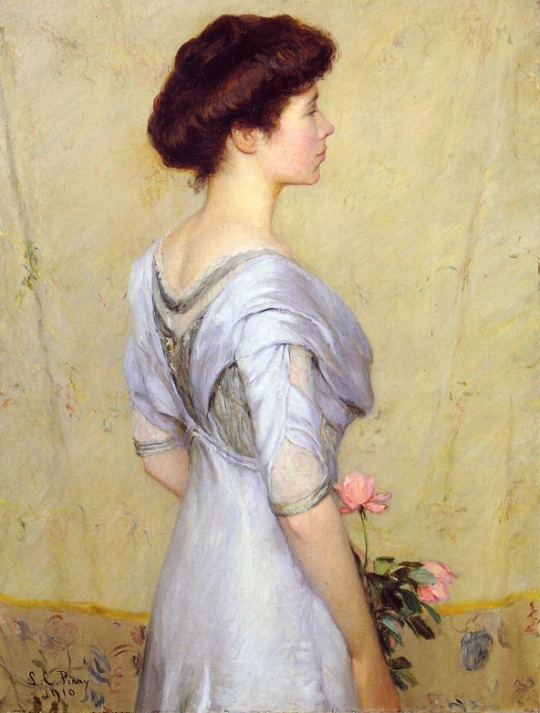
Left 1910 Vita Sackville-West by Philip Alexius de László (Sissinghurst Castle - Cranbrook, Kent UK) From the-athenaeum.org 842X1276.
Right ca. 1910 Baroness Emma Orczy by Bassano. From Wikimedia 758X988
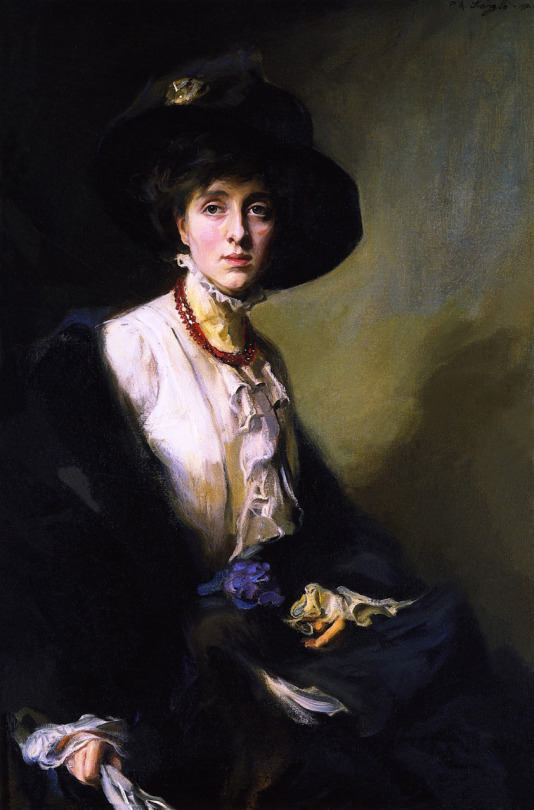
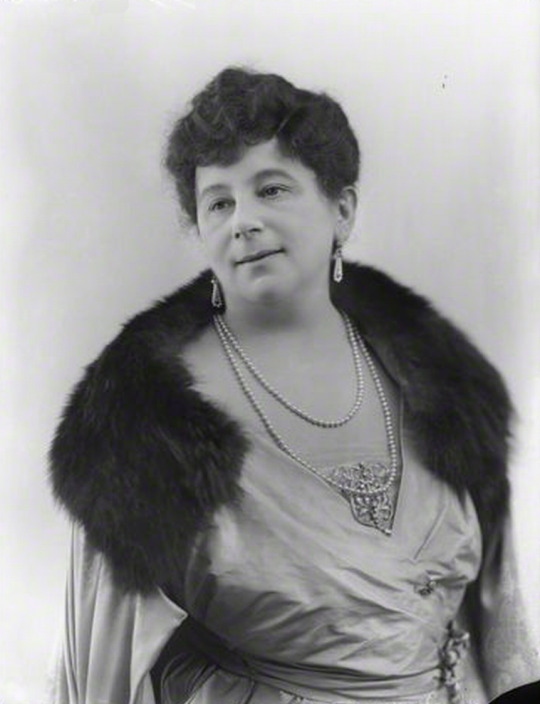
ca. 1908-1910 Paquin evening dress (Enchères Sadde via Interencheres). From tumblr.com-blog-view-fripperiesandfobs 1194X1092.

Left ca. 1910 Bertha Kalich by ?. From Wikimedia 1151X1507.
Right ca. 1910 Evelyn Duchess of Devonshire. From Mig_R's photostream on flickr; fixed spots w Pshop 589X796.
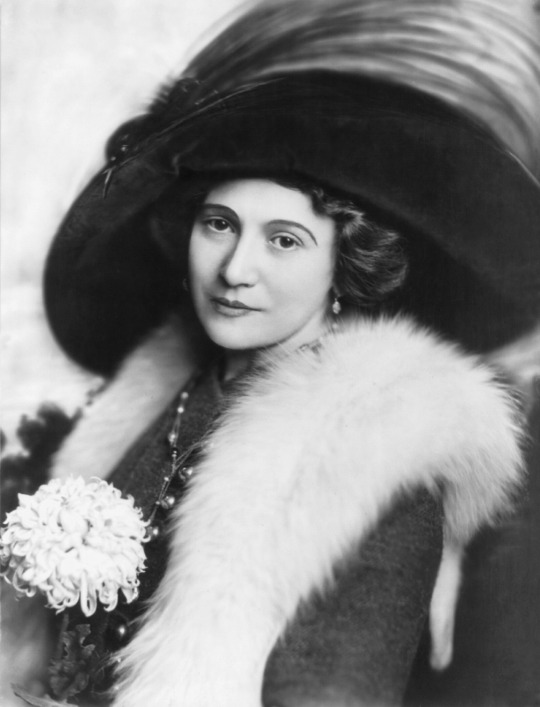
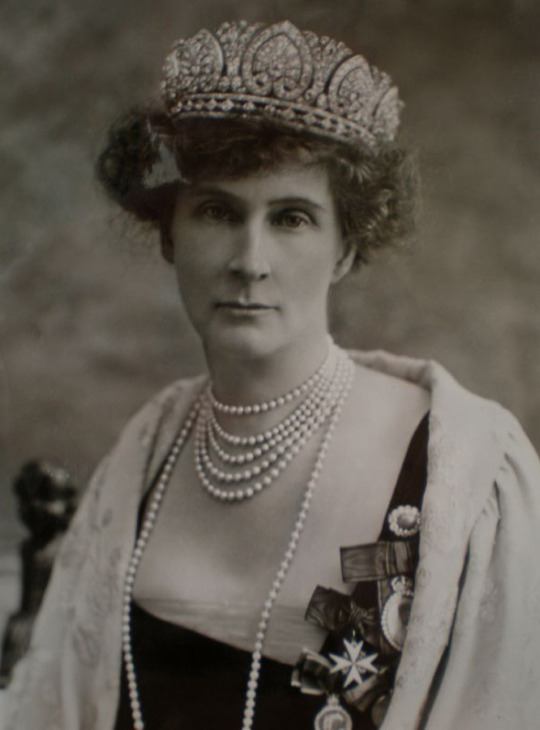
Left. ca. 1910 Mrs. Lancashire by Ignaz Gaugengigl (MFA). From Wikimedia 795X1132.
Right ca. 1910 On the River's Edge by Rose (private collection). From the discontinued Athenaeum Web site 776X974.


1910 (December) Femina cover. From picclick.fr/FEMINA-1910-238-Melle-ALICE-NORY-La-Belle-314811623435.html#&gid=1&pid=1 1668X2146.
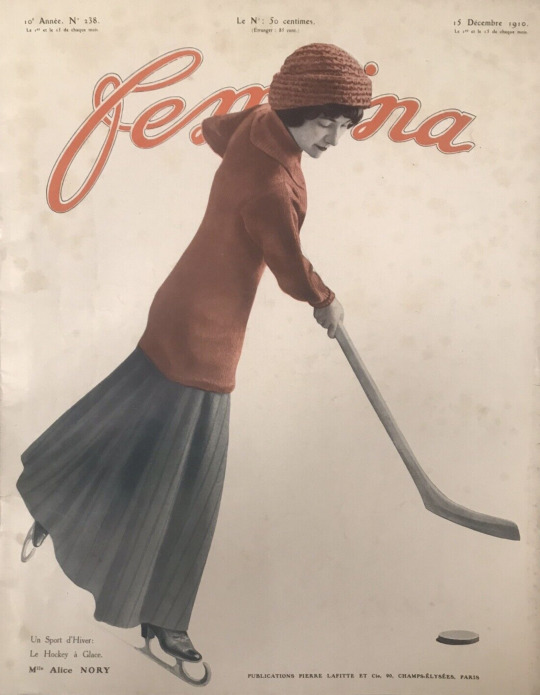
1910 Edwardian long line corset. From deloresmonet.hubpages.com/hub/FashionHistoryEdwardianFashionTrends1890a1914# 518X995.

#1910s fashion#1910 fashion#Belle Époque fashion#Edwardian fashion#Mary Rosamond Anstruther#James Jebusa Shannon#wide hat#day dress#high neckline#Eudolf Bering#Vera Nikolaevna Epancies#Alexander Murashko#wrap#William Strang#Vita Sackville-West#Philip Alexius de László#Emma Orczy#Bassano#Jeanne Paquin#Bertha Kalich#Evelyn Duchess of Devonshire#tiara#Mrs. Lancashire#Ignaz Gaugengigl#Guy Rose#Femina magazine#sportswear#corset#Whitney of Chicago#mother-of-the-bride ensemble
10 notes
·
View notes
Text
Wook-kyung Choi (1940–1985)
Wook-kyung Choi (1940–1985) was a Korean Abstract Expressionist painter. #PalianSHOW
Wook-kyung Choi, Untitled, Year unknown, Paint on paper 16 1/10 × 21 7/10 in | 41 × 55 cm Wook-kyung Choi (1940–1985) was a Korean Abstract Expressionist painter. She was born in Seoul, South Korea in 1940. She attended Seoul National University and then immigrated to the United States where she studied at the Cranbrook Academy of Art and the Brooklyn Museum Art School. In 1978 Choi returned to…
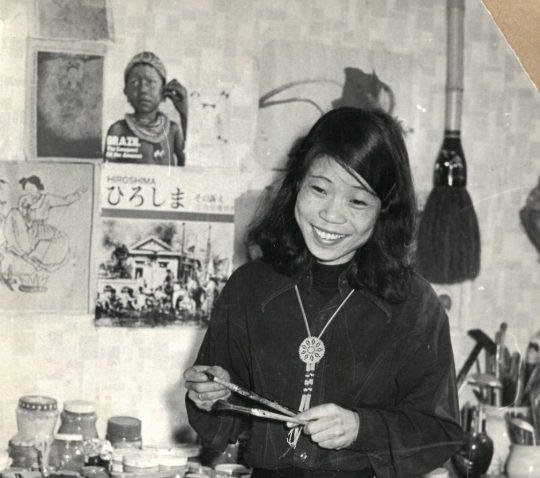
View On WordPress
#Abstract Expressionist#art herstory#asian artist#asian women artists#Choi#Korea#Korean#Korean Abstract Expressionist painter.#Korean women artists#painter#palian show#PalianSHOW#women painters#Women&039;s Art#Wook-kyung Choi
2 notes
·
View notes
Photo
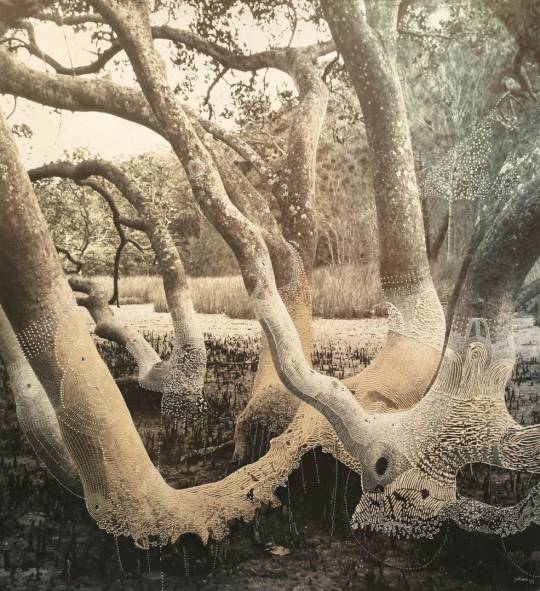
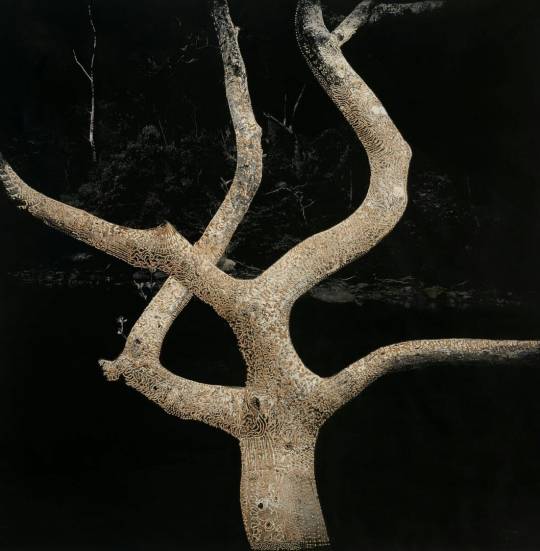
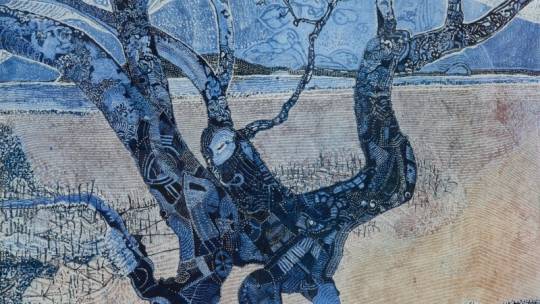

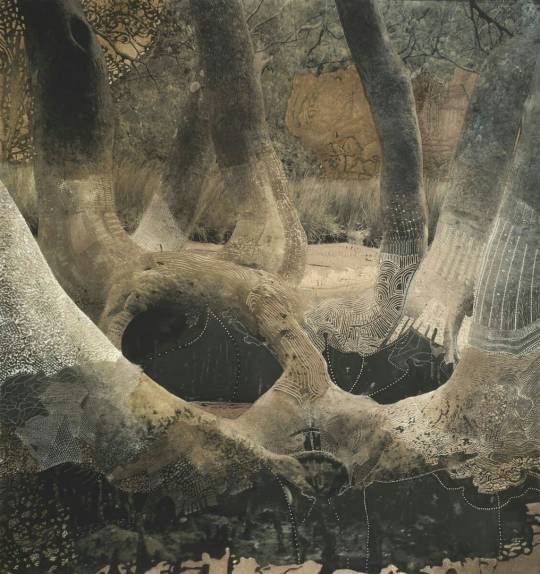
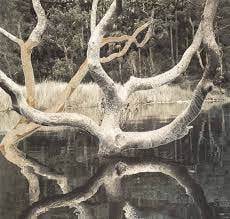

Trees by JOSHUA YELDHAM, (b 1970, Sydney, Australia)
The Yeldhams are one of Sydney’s notable families, but Joshua’s journal reveals that his privileged background was both a blessing and a curse. Suffering from dyslexia he had a terrible time as a boarder at Cranbrook, where he played the clown to compensate for his academic shortcomings, and to avoid being bullied. His next move, however, was to Switzerland, where he received a more cosmopolitan education and developed a taste for mountain climbing.From there Yeldham went on to the Rhode Island School of Design, where he became interested in filmmaking. His major student foray into the medium took him eleven times to the remote region of Mt. Humboldt in the Venezuelan Andes. The movie that resulted, Frailejón, would win an Emmy and an Oscar nomination for best student film in the United States for 1993. That hour-long movie is rarely seen today, but it is screening in the first room of this survey.For a young man of 23 such early plaudits might have been the launching pad for a career as a successful director, but when Yeldham was given $5,000 to develop the script of a second film, he used the money to buy a yellow Kombi and headed for the desert.
He seems to have had the same kind of experience as Robyn Davidson, but without camels. In brief: one goes to the desert to get lost and find oneself in the process. According to Yeldham’s journal this is roughly what happened, although when he tried to turn his experiences into a script it was rejected as too ethereal and not even faintly commercial. Perhaps he should have persevered – it took 40 years for Tracks to make it to the screen.
Returning to Sydney Yeldham gave up on the film world to pursue his burgeoning interest in the visual arts. He moved to the Hawkesbury with his partner, Jo, and began the love affair with Nature that has produced most of the work in this exhibition. This period has also produced two children, who have taken their places in the Yeldham vision of life, love, art and the universe. His journal, and perhaps the exhibition itself, is presented as an extended communication with his first child, Indigo.
The book and the art have such a private feel it seems strange to be writing about them as public artefacts. If this were a Hollywood movie, Indigo would find a dust-covered volume in the old family home after her parents had departed this world. She would begin to read, and the sound of her father’s voice would arise in her mind and the viewer’s ears. Soon we’d be in the midst of a lengthy flashback, as dad’s autobiography was replayed in glorious colour, interspersed with touches of homespun philosophy.
Putting it this way I can see why Yeldham chose the visual arts over cinema, although he has never totally abandoned the medium, as revealed by the very accomplished short film that concludes this show. The journal acts as an intimate, unconventional exhibition catalogue, full of notes, poems, sketches, memorabilia, artworks and snapshots.
Most of the work in this survey was completed on the Hawkesbury, including paintings, sculptures, drawings and engraved photographs. The latter are among Yeldham’s most innovative pieces. He prints a photo on a large slab of homemade paper, then carves back into it with a belt sander, which he uses with the delicacy of a fine etching tool. Trees grow patterns that resemble indigenous inscriptions on burial poles. Webs and pinpricks of white light cluster and sparkle amid the grey tones. Even his children get the treatment, being given white tattoos that cover half their bodies. Perhaps this is good parental psychology: they may be less tempted to get real ones when they’re old enough.
https://www.johnmcdonald.net.au/2014/joshua-yeldham/
https://www.smh.com.au/.../joshua-yeldhams-mystical-art...
18 notes
·
View notes
Text
Ilford Advocate Camera
It's been a year since I first laid eyes on the Ilford Advocate camera, and I've been eager to share my experience with it. The journey began in England, where my wife and I stumbled upon a charming camera and photo reseller, Juliano of Cameras London, on Portabello Road. Little did I know that this encounter would lead to the acquisition of a unique piece of photographic history.
My wife and I went to Portabello Rd in London on Friday to look at the antiques there and for me to look for photo items, which there were few of, but I was told that Juliano would be there the next day and he was the person to see. While there wasn't much time to return the next day, I took the bus early and arrived while Juliano set up. My intention wasn't to purchase an Advocate, but as we talked and I mentioned I had one before, he said he had a couple and was willing to part with one. He didn't have it with him, so we arranged to have it shipped to my home in the US.
When the camera arrived and a couple of other items I was buying from him, it was in excellent working condition. I was delighted, as the camera isn't typical but more of an oddity. While I collect "colored" cameras, the white color of this camera makes it stand out in the crowd of mainly back cameras. I was happy to have the Ilford Advocate back in the collection, in excellent working condition, and the full-fitted leather case, too.
The Company:
Ilford is known less for its cameras than for its film, photo paper, and now inkjet printing paper, at least within the photo community. The company has had a long history with many name changes. Still, it's always been a significant name in the photo industry before companies like Leica, Rollei, or even Kodak.
The original company name was Britannia Works, which was started by Alfred Harman in 1879 by making Gelatine Dry Plates in his basement on Cranbrook Rd, in Ilford, Essex. Harman initially started printing services in 1863, and in 1878, he patented "producing enlarged photographs with artistic finish." By 1880, Harman moved to Roden St. and started trading as Brittania Works Company. By 1883, the company was expanding with the popularity of photography, and Harman opened a new factory to produce plates.
By 1890, Harman produced a popular book, "The Manual of Photography," and the book, "The Ilford Manual of Photography," was created under that name until 1958, when it was in its 5th edition. In 1891, Kodak started producing plates in Harlow, Middlesex, as a competitor to Britannia Works. In 1897 and again in 1903, Eastman Kodak attempted to purchase Britannia Works Company, but both times were unsuccessful. In 1898, Alfred Harman retired at age 50 but did consulting work for many years. In 1900, the company changed its name to Ilford, Ltd. The town council was happy and objected, but with persistence, the name was changed.
In the 1960s, the company was owned by Ciba, and they merged with the French company Lumiere and Swiss company Tellko and became the Ilford Group. In 1989, the Ilford Group was purchased by the US-based International Paper Company, and together, they merged to become Ilford Anitec. From 1990 to now, the company has gone through a few other acquisitions and receiverships, and the current time is when the parent company is Harman Technology. Through it all, they still produce tremendous film, photo paper, film, and paper chemistry.
To my knowledge, only one camera manufacturer was under the Ilford umbrella in this long-winded explanation of the Ilford company. That is Kennedy Instruments Ltd., which designed and built the Advocate starting in 1947 and updated it in 1952. The rarely-seen Monobar cameras were produced from 1958 to 1967. All the other cameras with the Ilford name were created by companies like Dacora, AGI, or Kershaw-Soho.
My Camera:
The first thing I noticed about the camera, other than the apparent white color, is the weight of the camera. Or the camera's lack of weight as it's a very light camera. The camera is made from a die-cast aluminum body with an enameled white finish. The camera body is smooth to the touch and lacks any leather or leatherette, which is uncommon for cameras. My camera measures 5 3/8" wide by 3" tall by 2.5" deep and weighs 1lb 1.5oz without the fitted leather case.
The camera is straightforward and doesn't have a lot of extra knobs or buttons to do different things on a camera which is what makes this one so unique. To open the back to load the film, you only need to pull open the aluminum bar on the right side of the camera, which releases the lock holding the back closed. Once you open the, I noted chrome gear by the advancing cogs and onto the film advance spool. My first thought was, That's unusual. Then when I tried to put in the film, the rewind knob didn't pull up like the majority of 35mm cameras to load the film. As I poked around, I noticed that the rewind knob is actually hinged, and it pulls away from the body, which allows the photographer to put the film into the camera body.
It's always my inclination to put the film cassette into the camera first, then bring the leader to the take-up spool to load. But looking at the instruction manual, they suggest putting the film leader into the take-up spool first, then putting the cassette after. Having the rewind knob on a hinge makes perfect sense to do it that way. Once I put in the film, I always take the slack of the film with the rewind knob, so when I go to advance the film, I know the film is transporting when I see the rewind knob turn ad I advance to the next frame.
The only other settings needed to take photos are all around the Dallmeyer Anastigmat 35mm f3.5 lens on my camera. There are three different rings around the lens. On the outer or the largest ring, which has "Advocate" printed on the top, is the shutter speed dial, with speeds of 1/200, 1/150, 1/100, 1/50, 1/25, and "B," which are set according to a red dot on the out portion of the ring. The next ring from the shutter speeds is the focus distance, which has the closest focus distance of 3 feet to Infinity. The inner ring has aperture settings, which go from f3.5 to f22. My first inclination was that the inner ring, which is actually on the lens itself, would have the focus ability, but it's the aperture settings. I had to get used to that when shooting.
To take the photos, the shutter release is a pulling action as you pull the shutter release back towards the camera body as opposed to the most common pressing the shutter release down. It's more similar to an Exakta or Topcon Super D. You get used to it when shooting. The feel of the shutter is firm, and you can hear the rotary shutter releasing and firing, so there is no missing if the camera took the photo. There is an auxiliary remote shutter socket on the front of the camera if you choose to put the camera on a tripod and shoot with a more prolonged exposure.
The viewfinder on the camera is bright and easy to compose images. My camera is the second version made, as the original Advocate cameras didn't have the flash sync capability, which is located at about five O'clock on the lens and is a double-prong sync cable. The original model also has a chrome pressure plate to hold the film flat.
Here's the fun and one of the more exciting things I like about this camera. Once you've shot all the photos and want to rewind the film, there is no button to disengage the winding sprocket. All you need to do is press down the winding knob down, which presses the gearing system down, and the winding gear is free moving, and the film can easily rewind into the canister. I really enjoyed the simplicity of this system.
My Results:
I took the camera to a local farmers market and used a real "shoot from the hip" method. I tried to be somewhat discrete, which may be difficult with a bright white camera around your neck, but here are some of the results.
Conclusion:
I really enjoyed shooting with this camera. The biggest obstacle I had was remembering which ring did which function. I kept going back to the inner ring, which was closest to the lens and was the focus, but it was an aperture, so I needed to keep this in mind during shooting. If I were to use it more often, it wouldn't be that big of an issue; I also liked that the case was in excellent condition, which is only sometimes the case for older cameras.
Thank you for taking time from your schedule to look over this post.
Until next week, please be safe.
#Ilford#Ilford camera#35mm#35mm camera#35mm film#35mm film camera#british camera#rare camera#unusual camera#dallmeyer#dallmeyer lens#fun camera#wide angle#wide angle lens#white camera#street photography#alfred harman#ilford ltd.#harman technologies#Ilford film#ilford paper#Ilford England#Film maker
1 note
·
View note
Text
Evergreen Building Maintenance Inc.
Address : 1108 23 Ave N., #209 Cranbrook, BC V1C 5T6
Phone: (250) 581-1641
Email : [email protected]
Website: https://evergreenmaintenance.ca/
Evergreen Building Maintenance is trusted since 1988, because we do more than just make promises, we document the results. Vision: To be the best mid-sized service provider in Western Canada. Mission: Leading the development of an effective, efficient and sustainable company. Evergreen Building Maintenance Inc. is a dynamic organization aiming for excellence in every sector of building maintenance that we target. EBM currently provides commercial cleaning to more than 450 unique buildings in 23 different municipalities. Our consistent growth can be attributed to providing efficient, high standard and up-to-date cleaning services. By laying the necessary groundwork, we have prepared for the adaptation to larger operations. Our company’s reputation was built using a hands on philosophy – this meant making sure that any performance related concerns were addressed within the same business day. The difference between EBM and other corporations is that we do not franchise our services, we are fully owner operated. We also have regional managers and working supervisors who are available to attend to your requests. Our Services: Our mission is to provide a progressive experience for both clients and employees. Evergreen Building Maintenance has been an industry leader in British Columbia and the Okanagan area for more than 35 years, specializing in numerous commercial cleaning services which include:
Daily and Weekly Office Cleaning
Floor Stripping and Waxing
Steam Extraction Carpet/Upholstery Cleaning
Professional Window Cleaning
Garbage and Recycling Removal
Horizontal Surface Dusting
Stainless Steel and Metal Polish
Paper Shredding
Public Washroom Cleaning
Property Caretaking and Management
Parking Lot Maintenance
Litter Picking and Snow Removal
Hot Pressure Washing
Post Construction Clean-Up
Property Restoration
Sanitary Product Supply
Entrance Mat Supply and Maintenance About Us:
Evergreen Building Maintenance Inc. is a privately held company
EBM is fully bonded and insured
EBM is constantly trying to find innovative solutions for environmental preservation
EBM’s workforce is fortified through a proven network of local resources and suppliers
EBM employs a crew of 256 fully trained personnel, this ensures that we can provide replacements in case a staff member cannot make it to work
EBM complies to the B.C. Employment Standards Act and all WCB regulations
EBM’s operations perform 24/7, 365 days per year.
Keywords: Cranbrook Commercial Cleaning Services, Cranbrook Janitorial Services, Cranbrook Office Cleaning
Hour: 24/7/365
Year of the business : 1988
Number of Employee: 250+
Payment Method: Credit and Debit
Social Link :
Facebook : https://www.facebook.com/okanaganofficecleaning/
Instagram : https://www.instagram.com/evergreenbuildingmaintenance/
LinkedIn : https://www.linkedin.com/company/evergreen-building-maintenance/about/
1 note
·
View note
Text
This charmingly sweet painting on a paper bag was done by our client’s mother-in-law! We wanted to preserve the work in a traditional shadowbox, so we archivally mounted it onto a sage green mat from Crescent, presented it in a dark walnut moulding from Larson Juhl’s “Cranbrook” collection and completed the project with Tru Vue Museum glass.

Read the full article
0 notes
Photo

Dorthea Rockburne. Arena III, 1978.
#dorthea rockburne#rockburne#arena#paper#folds#folded#fold#paper fold#paper art#paper work#transparency#vellum#cranbrook art museum#archive#black mountain college
4 notes
·
View notes
Text
Florence Knoll
Florence Marguerite Schust era hija de Frederick Emanuel (1881-1923) y Mina Matilda (Haist) Schust (1884 -1931). Nació en la panadería de sus padres el 24 de mayo de 1917 y quedó huérfana a los doce años. Su padre, Frederick, era de de origen europeo, hablaba el alemán como lengua materna. La familia de su madre, Mina, nacida en Michigan, procedía de Canadá. Florence Schust creció en Saginaw,…
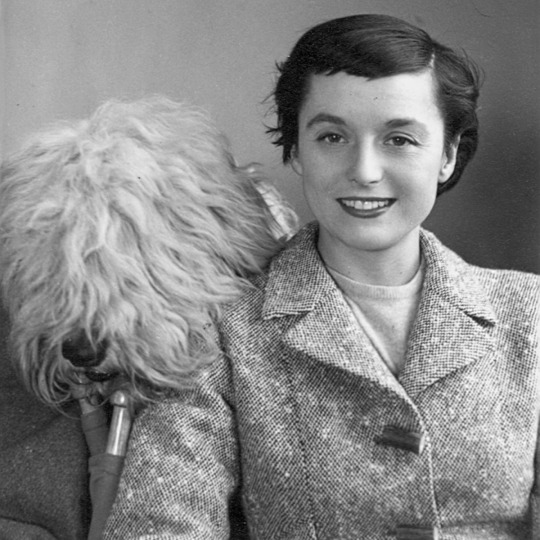
View On WordPress
#Architectural Association#Cranbrook#Eliel Saarinen#Florence Knoll#Hans Knoll#Harry Hood Bassett#Kingswood School#Knoll#Knoll Associates#Loja#MUJERES#The Papers
1 note
·
View note
Text

From our stacks: Illuminated letter 'N' from Cranbrook Papers By the Cranbrook Society, Detroit, Michigan, U.S.A. First Book. Printed and Illumined at The Cranbrook Press, 65 Shelby Street, Detroit, Michigan, U.S.A., and finished on the 31st day of August, 1901.
"And the illuminated letters, borders, and other ornaments used in Cranbrook Paper are copies from or made after the works of ancient masters as found contained in rare books and missals of the Fourteenth and Fifteenth centuries, no attempt having been made to modernize either the letters or other devices or to introduce coloring effects to please personal tastes. The examples herein contained of this interesting art are in strict harmony with the originals after which they were created."
#n#illuminated manuscript#squirrel#books#illustration#book#old books#book illustration#1901#cranbrook papers#cranbrook#detroit#michigan#library books#cranbrook press#detroit public library
45 notes
·
View notes
Text
Clue (1985)
This is one of my all-time favorite films. I have no clue why. It might be the nostalgia factor. But I’m absolutely obsessed with it. I’ve seen it a million times, but I have never looked into the interesting trivia on its IMDB page, so this will be fun!
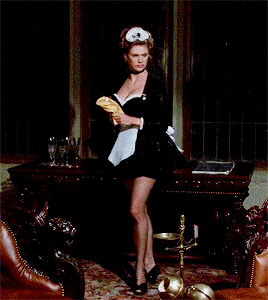
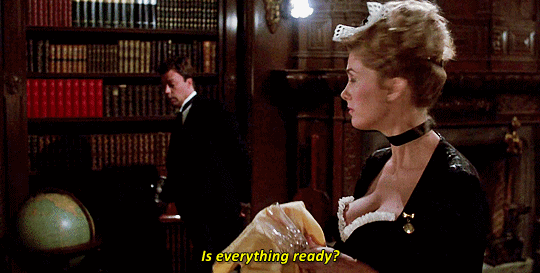
Awesome Fun Fact:
The color of each character's car is the same color as their playing piece in the game, and is introduced as follows: Colonel Mustard drives a yellow 1954 Cadillac Series 62, Mrs. White drives a black-and-white 1950 MG TD convertible, Mrs. Peacock drives a blue 1952 Packard 200 Deluxe club sedan, Mr. Green drives a green 1951 Plymouth Cranbrook, Ms. Scarlet drives a 1946 red Lincoln Continental, and Professor Plum drives a purple 1949 Pontiac Streamliner Station Wagon.
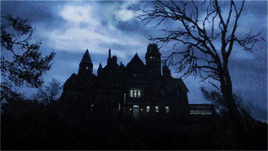

Prof. Plum: It’s frightened.

Something I Already Knew But Maybe You Didn’t: When Wadsworth cuts the power to the house during his solving of the mystery, it represents the point of divergence of the three endings.

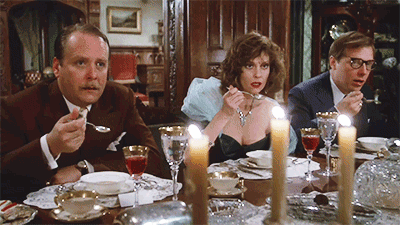

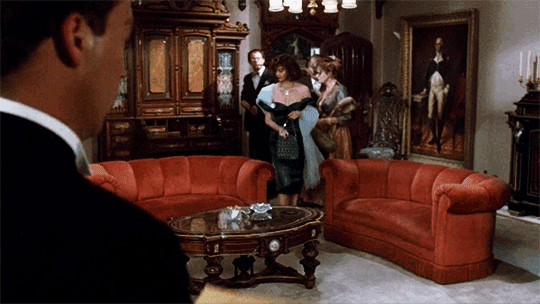
Amusing Fun Fact: Professor Plum indicates at dinner that he works for the World Health Organization, part of the United Nations Organization. This means he works for UNO WHO.
Wadsworth: Professor Plum -- you were once a professor of psychiatry specializing in helping paranoid and homicidal lunatics suffering from delusions of grandeur. Prof. Plum: Yes, but now I work for the United Nations. Wadsworth: So your work has not changed. But you don’t practice medicine at the U.N. His license to practice has been lifted; correct? Miss Scarlet: Why? What did he do? Wadsworth: You know what doctors aren’t allowed to do with their lady patients? Miss Scarlet: Yeah? Wadsworth: Well, he did. Miss Scarlet: Ha!
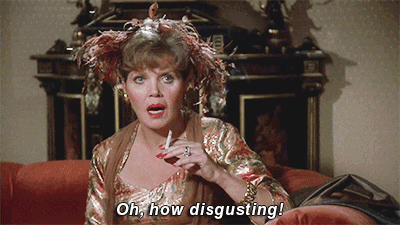
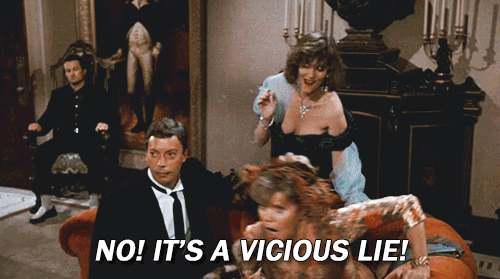
Mrs. White: [after Mrs. Peacock swears that the reason she's being blackmailed is a vicious lie] Well, I am willing to believe you. I, too, am being blackmailed for something I didn't do. Mr. Green: Me too. Colonel Mustard: And me. Miss Scarlet: Not me. Wadsworth: [surprised] You're *not* being blackmailed? Miss Scarlet: Oh, I’m being blackmailed all right, but I did what I’m being blackmailed for.
Miss Scarlet: Well, to be perfectly frank, I run a specialized hotel and a telephone service which provides gentlemen with the company of a young lady, for a short while. Professor Plum: Oh yeah? [pulls out pen and a pad of paper] Professor Plum: What's the phone number?
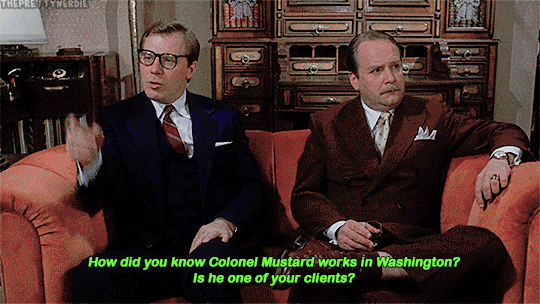
Wadsworth: The double negative has turned to proof positive. I’m afraid you gave yourself away. Colonel Mustard: Are you trying to make me look stupid in front of the other guests? Wadsworth: You don’t need any help from me, sir. Colonel Mustard: That’s right!

Wadsworth: Mrs. White, you've been paying our friend, the blackmailer, ever since your husband died under, shall we say, mysterious circumstances? Miss Scarlet: Ah! [laughs] Mrs. White: Why is that funny? Miss Scarlet: I see! That's why he was lying on his back, in his coffin. Mrs. White: I didn't kill him. Colonel Mustard: Then why are you paying the blackmailer? Mrs. White: I don’t want a scandal, do I? We had had a very humiliating public confrontation. He was deranged. He was -- [points to head] Mrs. White: -- a lunatic! He didn't actually seem to like me very much.

Miss Scarlet: Why would he wanna kill you in public? Wadsworth: I think she meant he threatened, in public, to kill her. Miss Scarlet: Oh. Was that his final word on the matter? Mrs. White: Being killed is pretty final, wouldn't you say? Wadsworth: And yet, he was the one who died, not you, Mrs. White, not you! Miss Scarlet: What did he do for a living? Mrs. White: He was a scientist, nuclear physics. Miss Scarlet: What was he like? Mrs. White: He was always a rather stupidly optimistic man. I mean, I'm afraid it came as a great shock to him when he died, but he was found dead at home.
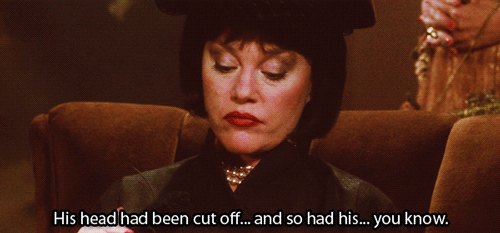
Mrs. White: I had been out all evening at the movies.
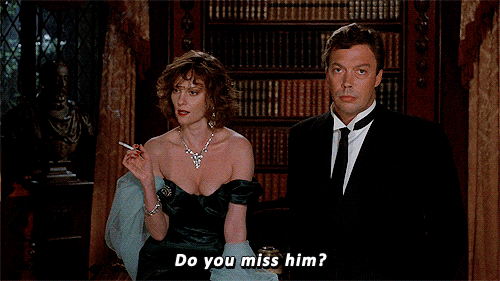
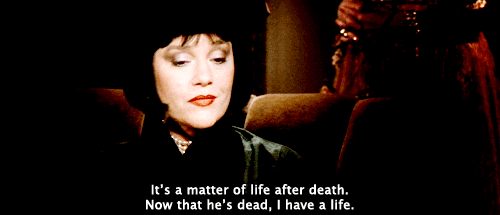
Wadsworth: But, he was your second husband. Your first husband also disappeared. Mrs. White: Well, that was his job. He was an illusionist. Wadsworth: But he never reappeared! Mrs. White: [chuckling, admittedly] He wasn't a very good illusionist.
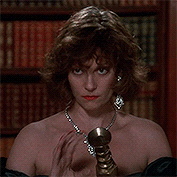
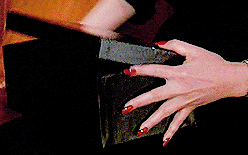


Prof. Plum: Maybe he was poisoned!
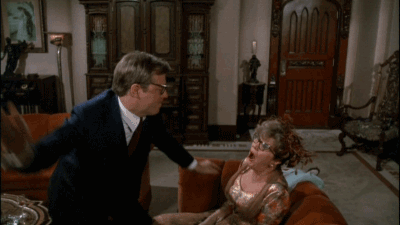
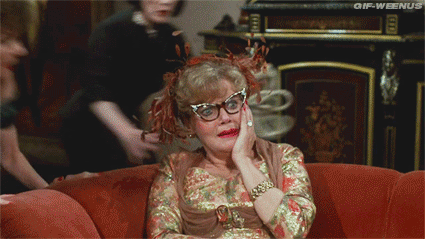
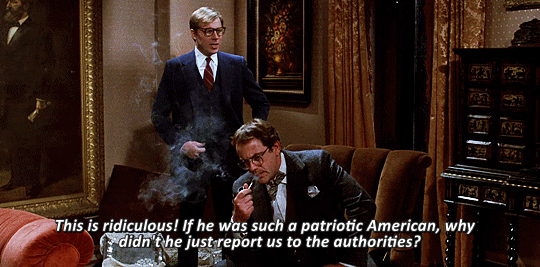
Wadsworth: He decided to put his information to good use and make a little money out of it. What could be more American than that?
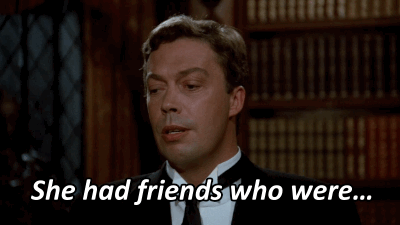


Col. Mustard: You lure men to their deaths like a spider with flies! Mrs. White: Flies are where men are most vulnerable.

Mrs. Peacock: No, I just want to powder my nose. Thank you.
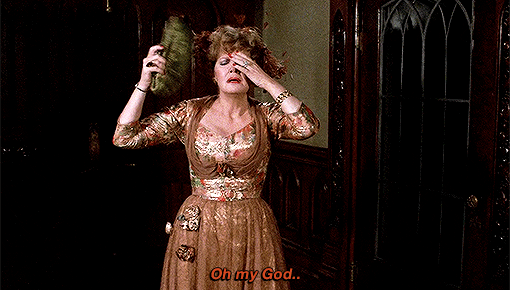
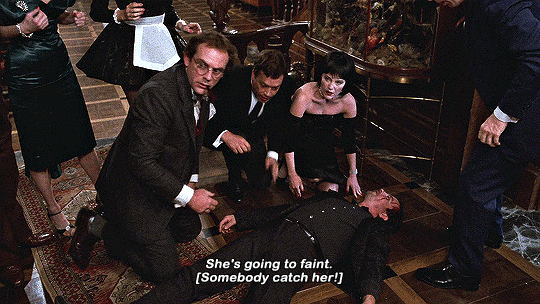

Wadsworth: Sorry!

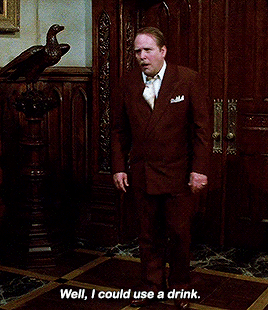

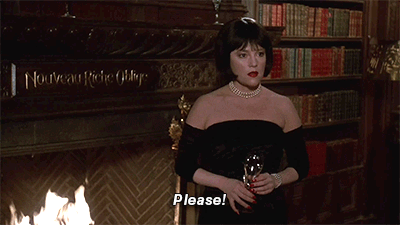


Wadsworth: The key is gone! Professor Plum: Never mind about the key, unlock the door! [smacks Mr. Green on the shoulder] Mr. Green: [grabs Professor Plum by the collar, throttling him] I CAN'T UNLOCK THE DOOR WITHOUT THE KEY! [releasing Plum, Mr. Green rattles doorknob] Mr. Green: LET US IN! LET US IN! Colonel Mustard, Miss Scarlet: [on other side of locked door] LET US OUT! LET US OUT!

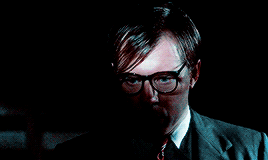

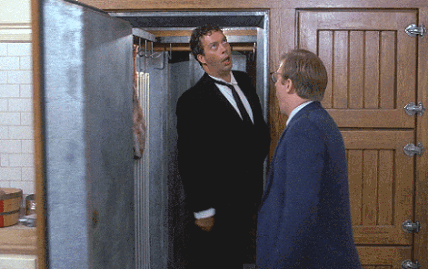
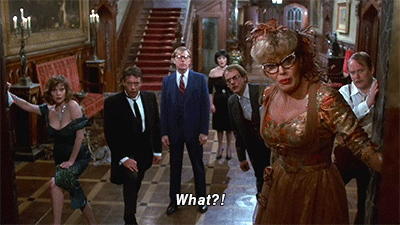
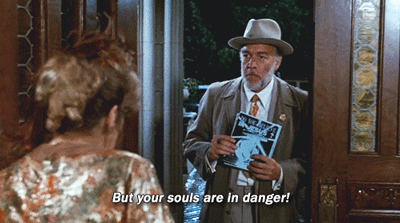
Mrs. Peacock: Our lives are in danger, ya beatnik!

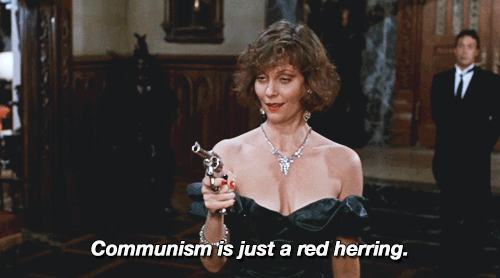
Communism is Just a Red Herring Fact: The line "Communism is just a red herring" is said in all three endings (twice by Wadsworth and once by Miss Scarlet). Not only is it is a pun (particularly after World War II, the Russian Communists were frequently called "reds", for example, the anti-Communist slogan, "Better dead than red."), but it cleverly refers to a MacGuffin (or a real "red herring") implemented by the screenwriters, because none of the murderers motives end up having anything to do with creating political conspiracy. There are various visual red herrings on-screen, such as a hammer and sickle on the shelf beside the torch Colonel Mustard finds, and a bust of Lenin in the attic.
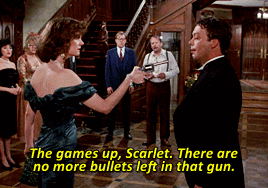
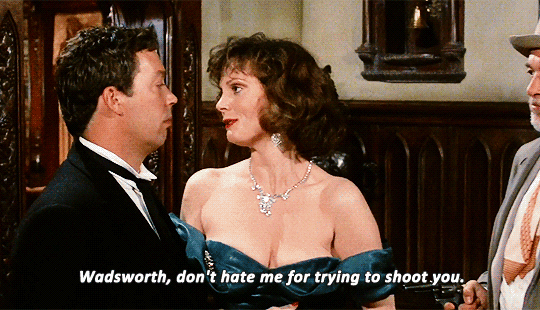
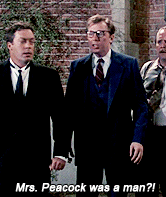
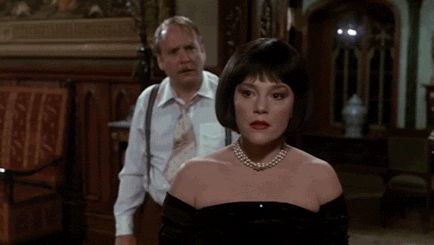
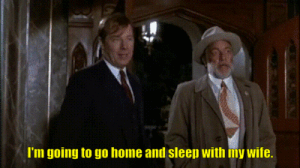
ESE: 125/100
50 +10 for Tim Curry +4 for the dogs +2 for the dog poo shoe +5 for Mr. Green’s obedience (”Sit! No, not you, sir.”) +1 for Mrs. Peacock’s glasses +5 for amazing one-liners +5 for the discussion about why Mrs. White’s being blackmailed -10 for homophobia -5 for The Three Stooges antics when Mr. Boddy’s secret is revealed +5 for not shouting +5 for confusion +5 for most hilarious pairings +10 for secret passages +3 for the ironing board +10 for singing telegram +10 for Wadsworth walking through the whole thing +6 for 3 different endings -10 because the timing makes no sense for Mrs. White to have killed Yvette +10 for Mr. Green going home to sleep with his wife +4 for Clue card credits
#Clue#Tim Curry#Christopher Lloyd#Michael McKean#Madeline Kahn#Eileen Brennan#Lesley Ann Warren#Colleen Camp#Martin Mull#Lee Ving#80s movies#80s films#movies#films#comedy#mystery#suspense#thriller#crime#review#world record
44 notes
·
View notes
Text
made some floating heads for the players!! now that i finally got to sit with them to do so.
players characters under the cut [as well as heavily cut summaries for em]
in order of creation-

“make me Carmen Sandiego! but sunglasses. Tremere wear sunglasses!” [anything specific you had in mind??] “aviators obviously!” [obviously]
Lulu Moncler- 13th generation Tremere on a mission to reconnect with the Cranbrook chantry after years away only to find it’s doors closed to any outside kindred. something to do with a former magister gone rogue. a story everyone in the city seems to have an opinion on.

“my hair but longer. regal like a panther.” [panther?] “or a mane. cause of the lion.” [okay a lion then..] “and a scar! right on the eyebrow.” [from what may i ask??] “paper cut.“
Seymour- a business oriented 13th generation Lasombra. who at the moment arrives to Detroit with the task of removing a rather pesky group of independent ghouls whove taken to the city. his personal ambitions though lie in real estate an the unclaimed territory popping up between the Camarilla and the Sabbat.

“you know that ice cream pokemon? i want that but way sadder looking. [sad ice cream okay..] “or no scratch that. maybe someone up to no good. like you look at him an just go ‘skeazy.” [skeazy ice cream yeah..]
Wyce- born at dusk hes a 14th generation thinblood. convinced his sire was something great an the visions will hit him eventually. hes running around learning all he can to remedy just that as he intends to simulate the madness network. a dangerous bit of alchemy should he actually learn how.
---
an these are are our.. starter pokemon now that i look at it. but a quick run up of the players before i figure out how im gonna retell the campaign on here. pictures sound nicer then a wall a text but uh. that might be to many to deal with since our campaigns normally go pretty rapid fire at the beginning. maybe headers. chapter it out in a way that sorta deal.
ill think of something.
#vtm#vampire the masquerade#vtm campaign#fangs that function#the characters are new to the city but the players sure arent#lets hope that doesnt effect to much of anything caus ei got neat location stuff to sort through#i already know it will though -.-#tremere#lasombra#thinblood
7 notes
·
View notes
Photo

Alexander Hamilton Memorial, Lincoln Park, Chicago, Perspective, Marx, Flint & Schonne Architects, 1950, Art Institute of Chicago: Architecture and Design
Kate Buckingham, Chicago philanthropist and patron of the arts, was best known for donating the iconic Buckingham Fountain in Grant Park. In 1928, she endowed a fund to build a memorial to Alexander Hamilton, which was unbuilt at the time of her death in 1937. During the 1930s, however, Buckingham commissioned sculptor John Angel to design a bronze statue of Hamilton, and Eliel Saarinen, the Finish-born architect and then president of the Cranbrook Academy of Art in Michigan, designed its monumental setting. Saarinen’s design called for a raised pavilion of four 80-foot, fluted granite columns crowned by a large bronze canopy. Although the trustees of the fund would later reject this design, Saarinen’s rendering for the project displays the restrained classicism of the memorial in an atmospheric setting that seems to recall the temple mounts of antiquity. When the project was finally advanced in the early 1950s, styles had changed, and a new design was commissioned from Samuel Marx, a sensuous modern architect and designer. His solution did away with classicizing columns, and instead installed the statue on a large stone base in front of a towering pylon made of polished black granite. Borrowing the scale and austere grandeur of the mid-century urban plaza, this design, while striking, can be viewed as out of scale and sympathy with the traditional bronze sculpture it was created to support. Today the sculpture stands alone in a flower garden, stripped of any traces of its monumental framing. Gift of Kate S. Buckingham Fund Size: 89 × 60.9 cm (35 1/16 × 24 in.) Medium: Graphite on white tracing paper, Green and brown pencil added
https://www.artic.edu/artworks/239385/
1 note
·
View note
Photo





Mary Walker Phillips (1923 – 2007) was an American textile artist, author and teacher. She revolutionised the craft of hand knitting by exploring knitting as an independent art form. In the catalog to her 1984 Fresno Arts Center exhibition, Jack Lenor Larsen described Phillips as the "transition between the old-fashioned, pattern-book knitting and the extraordinary things going on in England and America today." Her hand-knit tapestries and other creative pieces are exhibited in museums in the U.S. and Europe.
https://digitalcommons.unl.edu/cgi/viewcontent.cgi?referer=
https://en.wikipedia.org/&httpsredir=1&article=1709&context=tsaconf
Mary Walker Phillips was born in Fresno California on November 23, 1923. She enjoyed needlecrafts as a child, and received her BFA in weaving from Cranbrook Academy of Art in Bloomfield Hills, Michigan.
She moved to San Francisco in 1947 to work as a weaver in Dorothy Liebes’ studio. Phillips’ talent was acknowledged quite quickly, and in 1948 she received a telegram from Mrs. Frank Lloyd Wright, kindly commissioning her to produce drapery and interior fabrics for their home Taliesin West in Scottsdale, Arizona.
Afterwards, she travelled throughout Europe and moved to Fresno to freelance and teach weaving. In 1960, however, she returned Cranbrook for her MFA, focusing on experimental textiles. Upon her graduation in 1963, Phillips moved to an apartment on Horatio Street in New York City.
At the urging of her good friend, the textile designer Jack Lenor Larsen, Phillips deviated from her weaving practice to concentrate on knitting as a contemporary art form. In 1964, 100 of Phillips’ works were featured in a show at the Fresno Art Museum. These included woven upholstery, tie-dye blankets, rugs, double-weave wall hangings, knitted “illuminated cylinders” along with her ceramics.
True to her pioneering spirit in experimental materials and structures, Phillips utilized a myriad of natural and synthetic fibers – leather, mohair, asbestos thread, paper tape, seeds, and fiberglass amongst countless others. She created large-scale casement and upholstery textiles for architectural spaces, but her work eventually transitioned into knitted and macramé sculptures. Phillips’ shift from weaving to knitting and macramé signaled an important transition in the 20th century fiber arts movement, when textiles evolved from objects of utility to works of art.
Today Phillips is regarded as one of the most influential textile artists of the 20th century. Through weaving, knitting, macramé and her influential publications and teaching tenure, she was an important figure in not only the mid-century fiber arts movement but also the advancement of American studio craft. Phillips was a fellow of the American Craft Council, and her work is included in prestigious collections throughout the country – including the Museum of Modern Art, the Art Institute of Chicago and the Cooper Hewitt, Smithsonian Design Museum.
https://collection.cooperhewitt.org/people/18045647/bio#ch
19 notes
·
View notes